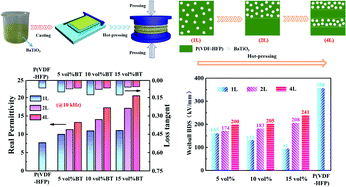Layer-structured BaTiO3/P(VDF–HFP) composites with concurrently improved dielectric permittivity and breakdown strength toward capacitive energy-storage applications†
Abstract
Polymer dielectric composites are of considerable interest for film capacitors that are widely used in modern electric devices and electric power systems. However, the adverse coupling between dielectric permittivity (εr) and breakdown strength (Eb) makes it difficult to obtain high energy densities in natural materials. With the aim of achieving concurrently improved εr and Eb, a class of rationally designed layer-structured composites consisting of pure poly(vinylidene fluoride–hexafluoropropylene) (P(VDF–HFP)) layers and barium titanate/P(VDF–HFP) (BT/P(VDF–HFP)) composite layers were prepared. Interestingly, the layer-structured composites exhibit a concurrent improvement of εr and Eb. The 4-layer composite with 15 vol% BT exhibits substantially enhanced εr and Eb which are nearly ∼186% and ∼248% of those for its 1-layer counterpart, respectively. Consequently, a high energy density of ∼4 J cm−3 along with a satisfactory efficiency of 71% at 240 kV mm−1 is achieved. Meanwhile, a low loss tangent of ∼0.05 at 10 kHz which is comparable to that of pure P(VDF–HFP) is maintained. This work shows that the adverse coupling between εr and Eb in dielectric materials could be well addressed by constructing nanocomposites with layered rather than random distribution of fillers.



 Please wait while we load your content...
Please wait while we load your content...